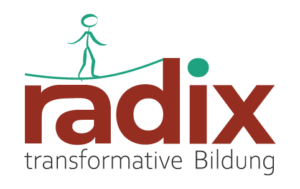Brief description
In this method, participants can give space to their creativity and create a picture of their very own utopias.
Learning objectives
The participants…
- gain a playful and creative approach to the topic of utopias.
- broaden their view of utopias.
- gain experience in their own „utopian thinking“ and that of the other participants.
- have time to reflect on and process what they have learned.
Procedure
Background
The worsening climate crisis and growing social inequality make clear: business as usual is neither possible nor desirable. We need social change on a grand scale. But what can a future look like in which people in all their diversity are valued worldwide and can live freely and self-determined lives? And in which an environment worth living in, is preserved at the same time?
Each of us has different ideas of a societal utopia. What is particularly important to us, is valued differently. This exercise is about creatively exploring and expressing one‘s own ideas of utopia.
Preparation
Before the unit: If necessary, participants can be asked a few days in advance to bring their own craft materials for the utopian collage to the workshop. The content note (see „Tips and Notes for facilitators“) should be communicated before the start of the unit. Before the unit begins, all craft materials are placed in the middle of the room. The question „When you think of utopia, what images and thoughts come to your mind?“ can be written on a flipchart and hung up in the room for all to see.
Implementation
1. (5-10 minutes) Introduction
The procedure is explained to the whole group: participants have the same amount of time to make a collage on the question „When you think of utopia, what images and thoughts come to mind?“. The participants can choose whether they want to create a collage on their own or together with other people. There is also the option of not creating a collage. At this point, a mood survey is helpful: If participants feel like joining forces with other people, they can wave their hands in the air. If participants would rather do the craft alone or do something else, they can wave their hands in the air at the bottom. If participants are not sure yet, they can wave their hands in the middle. If individual participants want to say something for everyone, they can do so afterwards (e.g. „I’m not going to make a collage and would rather go for a walk. If anyone would like to join me, please speak to me“).
2. (5 minutes) Finding Phase
While the facilitators turn on calm background music, the participants get together in groups if necessary and gather all the materials they need for the collage. Participants look for a place where they want to work. Materials are still available in the room and can be exchanged.
3. (45-60 minutes) Crafting
The participants now have approx. 45-60 minutes to assemble their mashup. As soon as the mashups are finished, the participants can hang them up in the room – thus creating an exhibition of utopian collages.
4. (10-15 minutes) Break
Possibly a short break – At this point, the group can also bring people back in, who have not made a mashup.
5. (20-30 minutes) Evaluation
A gallery is created from the participants‘ mashups hung up in the room. The participants now move through the gallery as a group to look at the mashups they have made. The group stops at each mashup to look at it. The artists are invited to say something about their collage and the rest of the group can – in agreement with the artists – share their thoughts on it.
After all the exhibits have been viewed, the group meets again in a circle of chairs for a final reflection. The following questions can serve as impulses:
- What goes through your mind after you have looked at the different exhibits?
- What defines your very own utopia? What has played an important role for you when creating the mashup?
- Was it easy/difficult for you to find suitable materials? How did you feel about it?
Variants
In step 5 there is scope for design. Here are a few inspirations:
- The gallery is designed as an exhibition opening: The participants are welcomed at the beginning of the exhibition with an opening speech. This could look something like this: „Welcome to GaleriUtopia. XX artists have explored their own personal idea of utopia and have put this gallery together for you today. You are now cordially invited to walk through the gallery and let the works of art have an effect on you. See what it does to you, see if you recognize any similarities. Today you are in the very special situation of having all the artists present and being able to talk to them later. But for now, have fun in the gallery. Drinks and snacks may be available.
- Participants go and look at the exhibits separately from the group and do not speak or only speak in a whisper.
As an alternative for participants who consciously decide against creating a collage, facilitators can suggest the following alternatives, for example:
- Books, audios and videos on the topic of utopias are made available for reading/listening/watching.
- Participants can go for a walk and discover what would have to change in their environment to shape their utopia; or what they already perceive as „utopian“ in the here and now.
- Participants can think about a still image and later exhibit it.
Tips and Notes for Facilitators
Content Note: The method involves cutting with scissors. Collage making is also used in psychotherapeutic settings. For some people, this can evoke unpleasant memories that are often associated with psychological crises or illnesses. It is therefore important to be transparent about what will happen in advance and to give participants the option of not taking part in the exercise (see variants).
The method is particularly suitable for concluding a content-related discussion of utopias. This gives participants the opportunity to creatively present new knowledge, new ideas and experiences from their exploration of utopias.
Possibilities for further work
This method can be well introduced with a dream journey.
Funded by the European Union. Views and opinions expressed are however those of the author(s) only and do not necessarily reflect those of the European Union or the European Education and Culture Executive Agency (EACEA). Neither the European Union nor EACEA can be held responsible for them.

